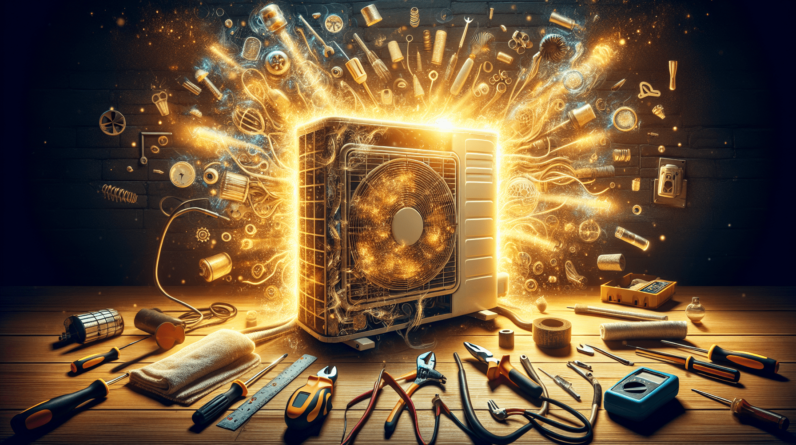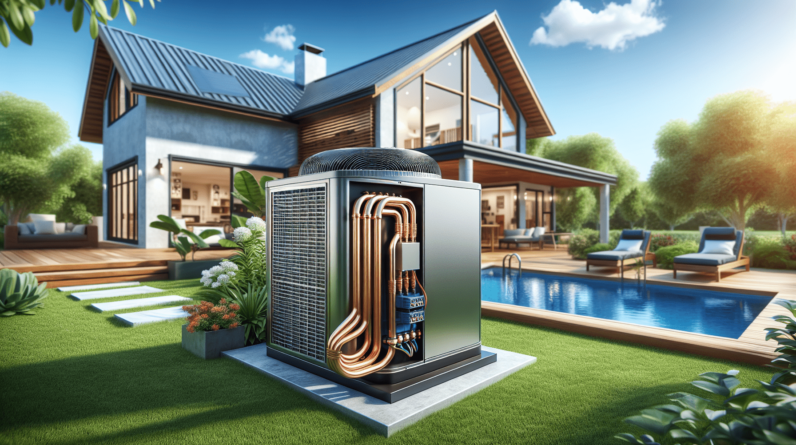
Imagine this scenario: you’re at home, comfortably sitting on your favorite couch, engrossed in an intense movie. Suddenly, everything goes dark, leaving you in complete darkness. Your heart skips a beat, and you realize that a power surge has disrupted your evening. But don’t panic! In this article, we will explore the do’s and don’ts of fixing a power surge, empowering you to quickly restore the flow of electricity and get back to enjoying your movie marathon.
Causes of Power Surges
Internal Power Surge
Internal power surges occur when there is a sudden increase in electrical voltage within your home’s electrical system. These surges are usually caused by the operation of large appliances, such as refrigerators or air conditioners, that utilize a significant amount of power when they turn on and off. Additionally, faulty wiring or inadequate grounding within your home can also lead to internal power surges.
External Power Surge
External power surges are caused by events that occur outside of your home, often originating from the power grid. These surges can happen when there is a sudden increase in electrical demand, such as during a blackout or when power is restored after an outage. Additionally, events like lightning strikes or downed power lines can also introduce external power surges into your home’s electrical system.
Lightning Strikes
Lightning strikes are one of the most common causes of power surges. When lightning strikes a power line or a nearby object, it can introduce a massive surge of electrical energy into the electrical grid. This energy then travels through the power lines and can enter your home, potentially damaging your electronic devices and appliances.
Electrical Grid Issues
Issues within the electrical grid can also cause power surges. These issues can range from equipment failures to overloading of the power grid due to spikes in electricity demand. When these issues occur, they can send an excessive amount of voltage into your home, leading to power surges and potential damage to your electrical devices.
Identifying Power Surge
Sudden Loss of Power
A sudden loss of power is a clear indication that a power surge may have occurred. If your lights suddenly go out and your electronic devices shut down without warning, it could be a sign that a power surge has taken place.
Flickering Lights
Flickering lights are another common indicator of a power surge. If you notice your lights dimming or flickering, especially when you turn on a large appliance, it could mean that there is a fluctuation in electrical voltage.
Blown Fuses or Tripped Breakers
Power surges can cause the electrical system in your home to overload, resulting in blown fuses or tripped circuit breakers. If you find that your fuses are constantly blowing or your circuit breakers are frequently tripping, it may be a sign of power surges occurring.
Burnt Smell or Strange Noises
If you detect a burnt smell or hear strange noises coming from your outlets or electrical panel, it may indicate that a power surge has caused damage to the wiring or electrical components of your home.
Malfunctioning Electronics
When electronic devices suddenly stop working or exhibit erratic behaviors, it could be a result of a power surge. If multiple devices experience issues at the same time, it is important to consider the possibility of a power surge.
Potential Damage
Electronics and Appliances
Power surges can severely damage your electronic devices and appliances. The excessive electricity can overload and fry delicate circuitry, rendering them useless. Even if they continue to function after a power surge, the internal damage may shorten their lifespan significantly.
Data Loss
Power surges can also lead to data loss. If you have electronic devices, such as computers or external hard drives, that store important data, a power surge can corrupt or erase your files, resulting in the loss of valuable information.
Electrical Fires
In extreme cases, power surges can even cause electrical fires. The excessive electrical energy can cause wires to overheat and ignite, potentially resulting in significant damage to your home and posing a serious threat to your safety.
Safety Hazards
Power surges can create safety hazards within your home. If your electrical devices become damaged due to a power surge, they may emit smoke or sparks, increasing the risk of electrocution or fire. Additionally, power surges can also damage the wiring and insulation within your home, leading to a higher risk of electrical shock.
Preventive Measures
Whole-House Surge Protection
Installing a whole-house surge protection system can be an effective measure to prevent power surges. These systems are typically installed at your electrical panel and provide protection for your entire home by diverting excess voltage away from your electrical devices and appliances.
Point-of-Use Surge Protectors
Using point-of-use surge protectors is another way to safeguard your electronics. These devices plug directly into your outlets and act as a barrier, absorbing or redirecting excessive voltage away from your devices. It is important to choose surge protectors with adequate joule ratings to ensure optimal protection.
Unplugging Electronics
When a power surge is expected, such as during a thunderstorm or when leaving your home for an extended period, it is wise to unplug your electronic devices. This simple action can prevent them from being exposed to the damaging effects of a power surge.
Avoiding Overloading Circuits
Avoid overloading your electrical circuits by distributing the power demand evenly. Using extension cords and power strips sparingly and not plugging multiple high-wattage appliances into the same outlet can help reduce the risk of power surges.
Proper Grounding
Ensuring that your electrical system is properly grounded is crucial in protecting against power surges. Grounding provides a safe path for excess electrical energy to be dispersed, preventing it from causing damage to your devices. It is advisable to have a licensed electrician inspect and update your home’s grounding system if needed.

Resetting Basic Power Surges
Unplug Devices
If you suspect a power surge has occurred, it is recommended to unplug your devices from the outlets. This can prevent any residual power from causing damage when the power is restored.
Reset Circuit Breakers
If your circuit breaker trips as a result of a power surge, you can reset it by flipping the corresponding switch back to the “on” position. However, it is important to identify and address the cause of the power surge to prevent it from happening again.
Replace Blown Fuses
In the case of blown fuses, it is necessary to replace them with new ones of the appropriate amperage rating. This will restore the functionality of your electrical system and protect it from further damage.
Utilize Surge Protectors
If you have surge protectors installed, they may need to be reset after a power surge. Most surge protectors have reset buttons or switches that allow you to restore their functionality and continuous protection.
Seeking Professional Help
Calling an Electrician
If you experience frequent power surges or suspect significant damage to your electrical system, it is best to seek assistance from a licensed electrician. They can diagnose the problem, assess the condition of your wiring and equipment, and provide appropriate solutions to protect your home from future power surges.
Power Company Assistance
In some cases, power surges may be caused by issues with the electrical grid or the power supplied by your utility company. If you suspect this to be the case, contacting your power company and reporting the problem can help resolve the issue and prevent further damage.
Repairing Damaged Electronic Devices
Assessing the Damage
After a power surge, it is important to assess the damage to your electronic devices. Inspect them for any visible signs of damage, such as burnt components or unusual odors. If the damage is extensive, it may be necessary to contact a professional repair service or the device manufacturer.
Contacting Manufacturer or Professional Repair Service
For valuable or complex electronic devices, it is recommended to contact the manufacturer or a professional repair service. They have the expertise and knowledge to assess the extent of the damage, provide repairs, and ensure that your devices are safe to use again.
Consider Insurance Claims
Power surge damage may be covered by your homeowner’s insurance policy. It is advisable to review your policy and determine the coverage for power surge-related incidents. If applicable, filing an insurance claim can help alleviate the financial burden of repairing or replacing damaged devices.
Insurance Coverage
Understanding Policy Coverage
Before a power surge occurs, it is crucial to understand your homeowner’s insurance policy and its coverage regarding power surge damage. Familiarize yourself with the terms, limits, and exclusions to ensure you have appropriate coverage for potential losses.
Documenting the Damage
In the event of a power surge, it is important to document the damage to your electronic devices. Take photographs or videos of the damaged items, make a list of the affected devices, and gather any receipts or proof of purchase that can support your insurance claim.
Filing a Claim
When filing an insurance claim for power surge damage, contact your insurance provider and provide them with the necessary documentation. They will guide you through the claims process, including providing estimates, scheduling inspections, and arranging for replacements or repairs.
Safety Precautions
Turning Off Power
When working on your electrical system or handling devices during or after a power surge, it is crucial to turn off the power supply to ensure your safety. Switch off the main breaker or the relevant circuit breakers before conducting any inspections or repairs.
Using Insulated Tools
When working on your electrical system, always use insulated tools to reduce the risk of electrical shock. Insulated tools have handles and shafts made from non-conductive materials, providing a layer of protection against accidental contact with live wires.
Proper Wiring Techniques
Proper wiring techniques are essential in preventing power surges and reducing the risk of electrical hazards. Ensure that all electrical connections are securely made, wires are not frayed or exposed, and outlets are grounded correctly. If unsure, consult a licensed electrician for assistance.
Regular Maintenance
To minimize the risk of power surges, it is important to regularly maintain and inspect your electrical system. Have a professional electrician conduct periodic inspections, identify potential issues, and perform necessary repairs or upgrades to keep your system in optimal condition.
Conclusion
Power surges can pose a significant threat to your electrical devices, appliances, and even your safety. By understanding the causes, identifying the signs, and implementing preventive measures, you can protect your home from potential damage caused by power surges. Additionally, knowing how to reset basic power surges, seek professional help when needed, and navigate insurance claims can help you recover from any damage that may occur. Remember, prioritizing safety precautions and regular maintenance will go a long way in ensuring the longevity and reliability of your electrical system.






